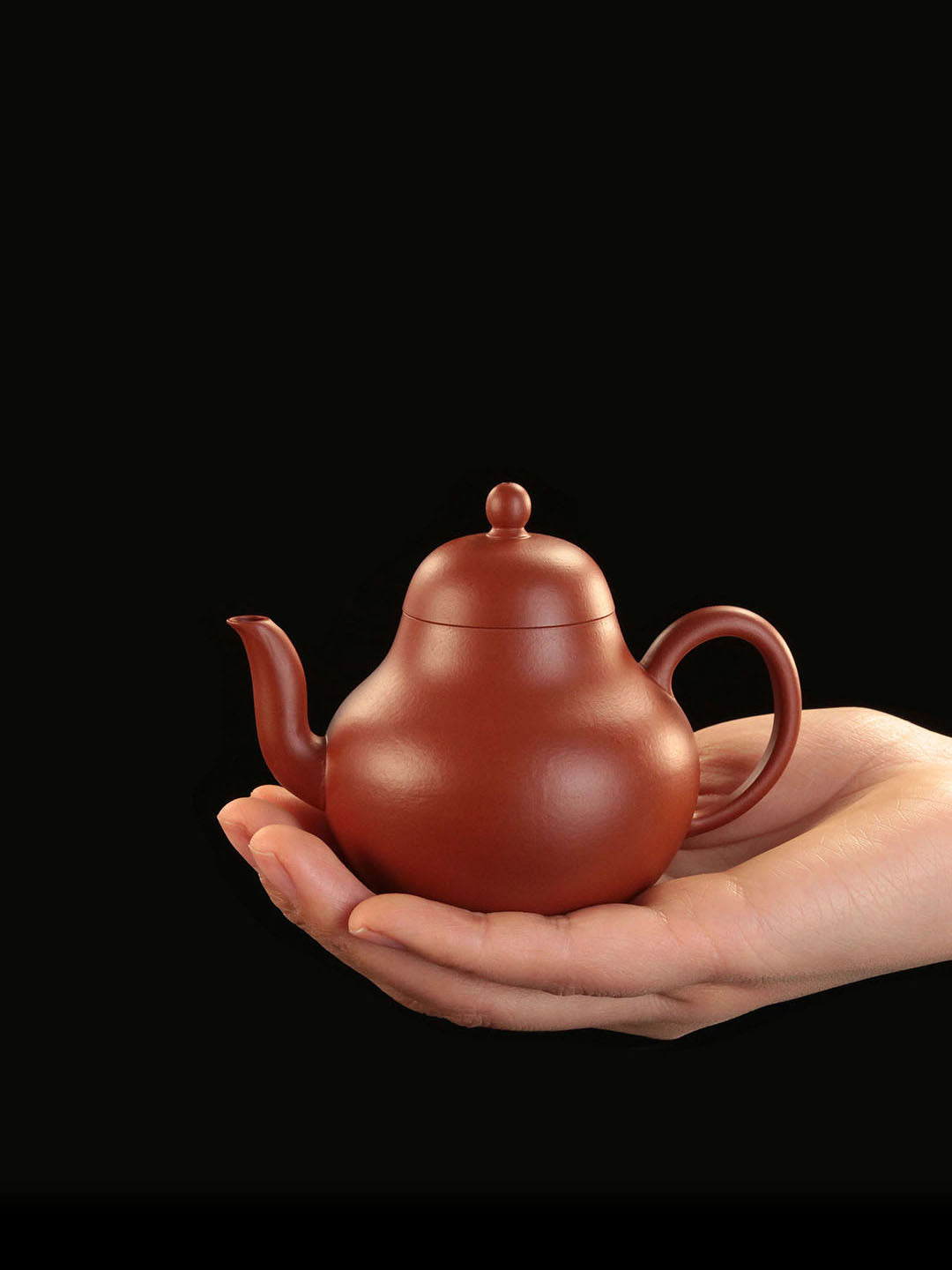
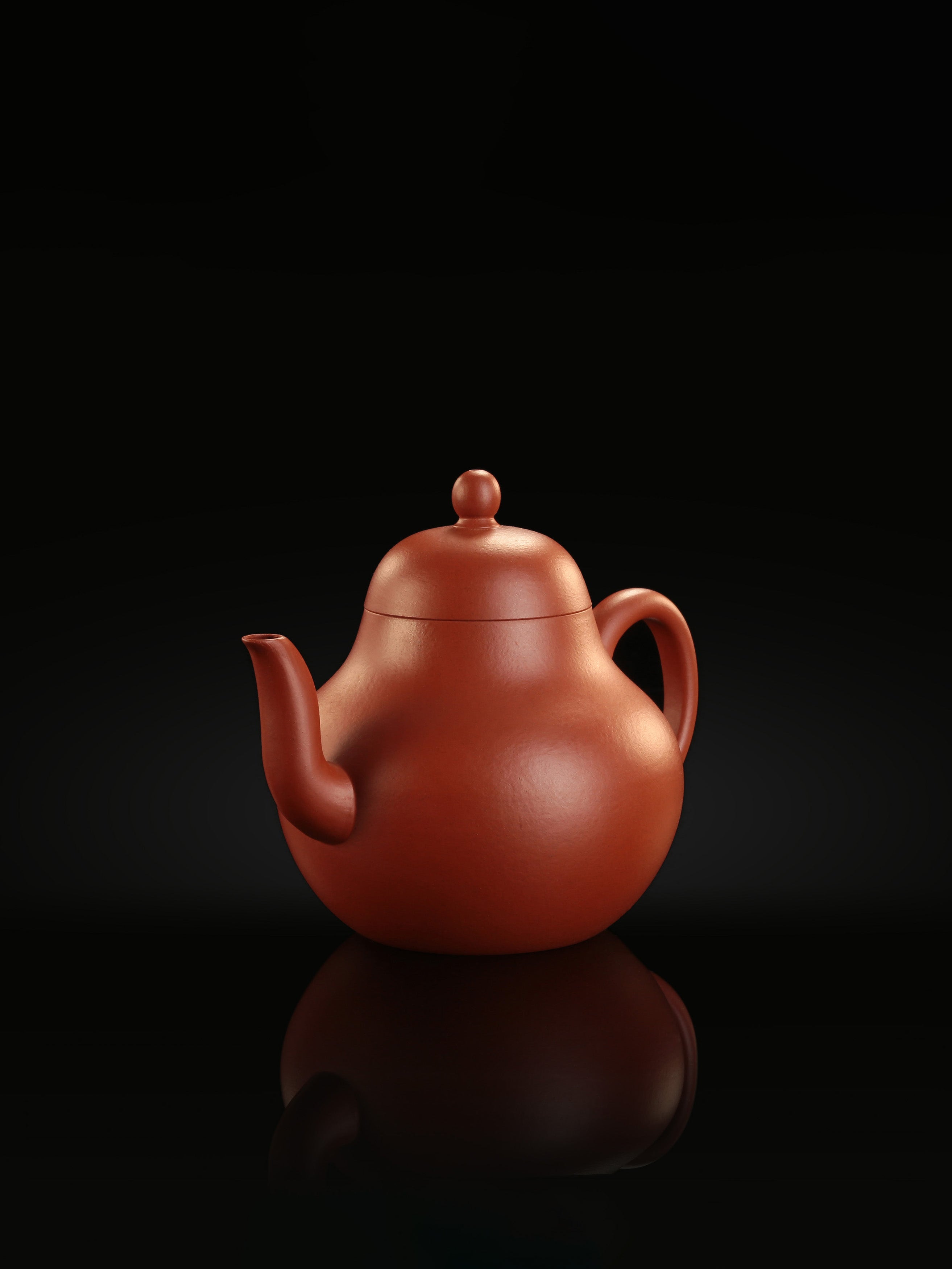
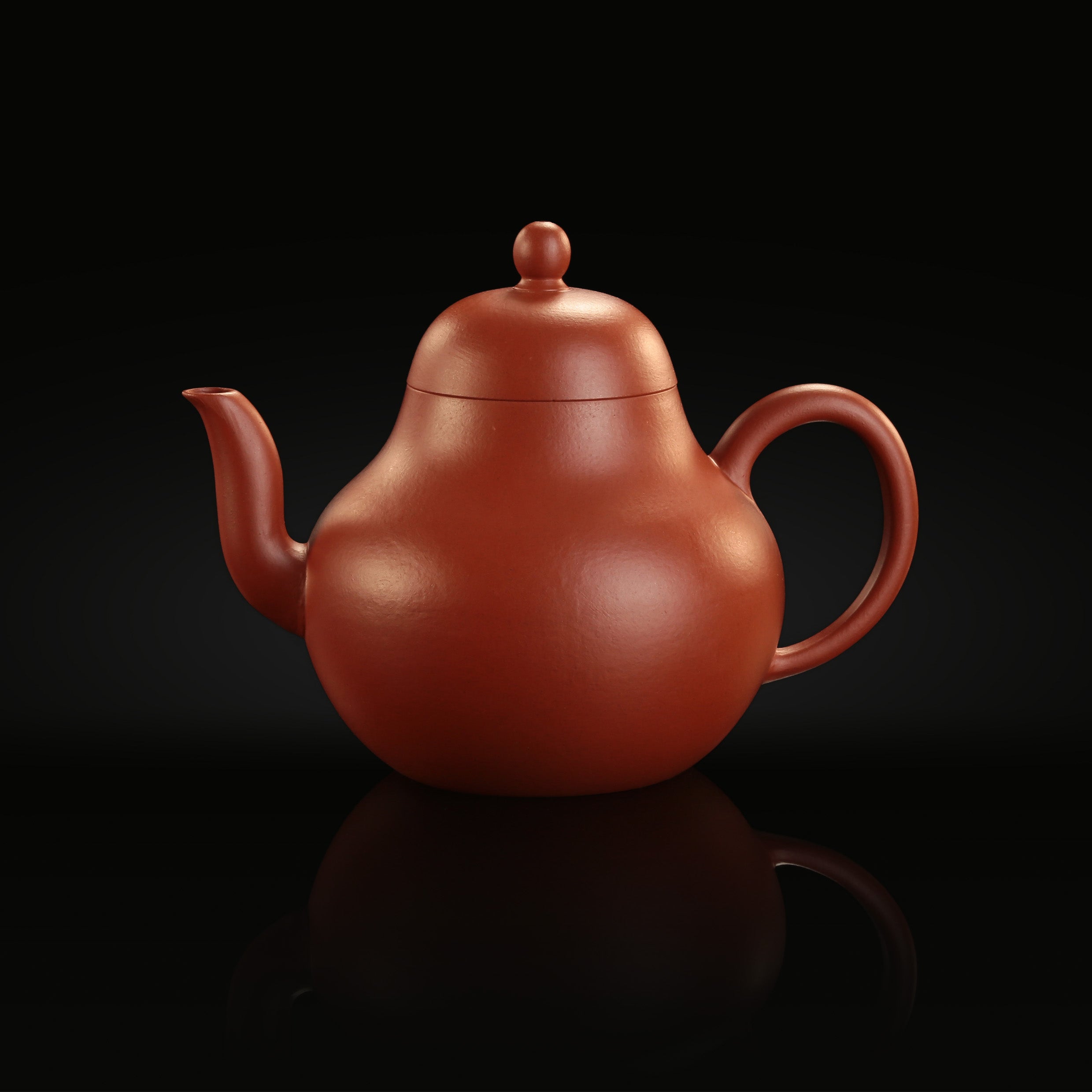
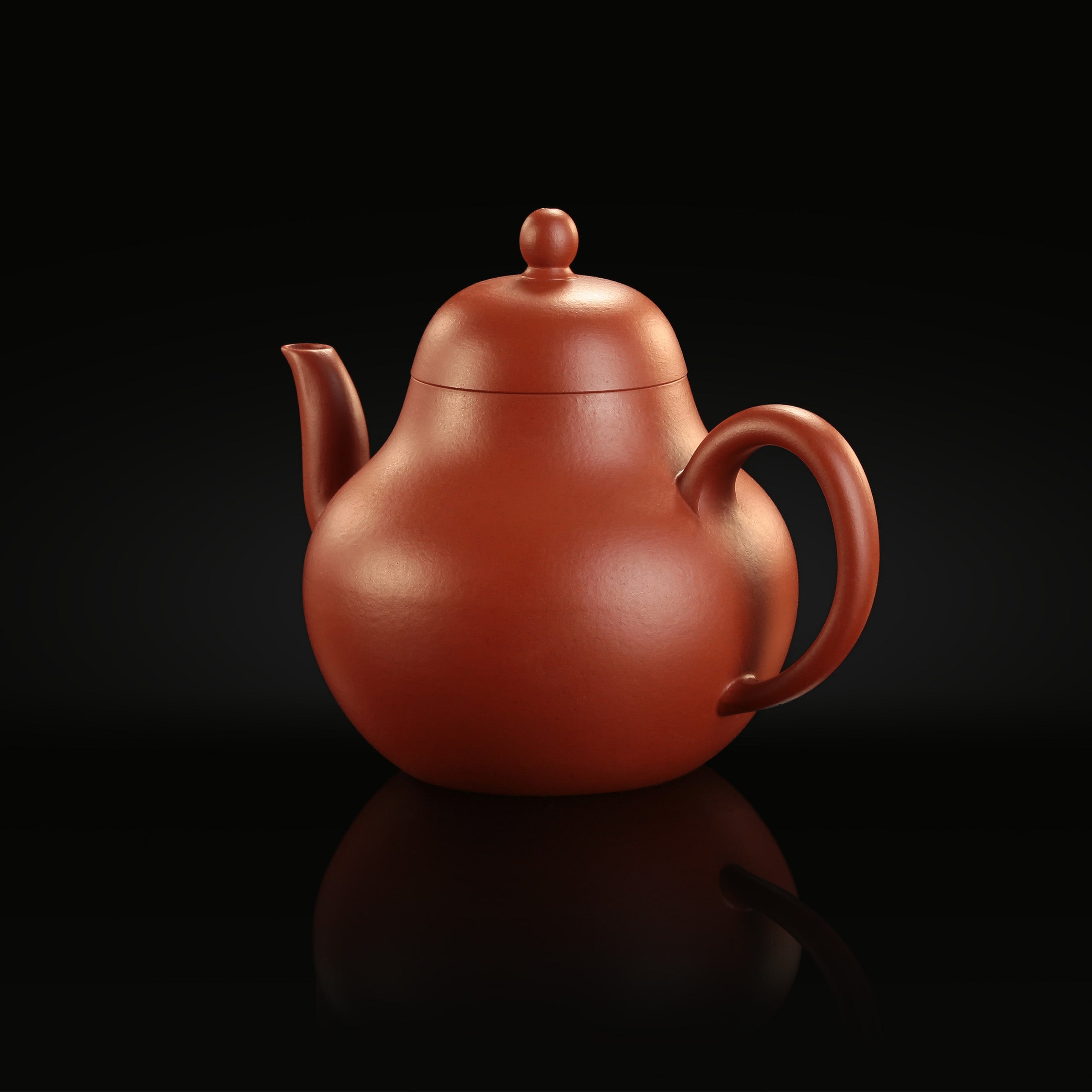
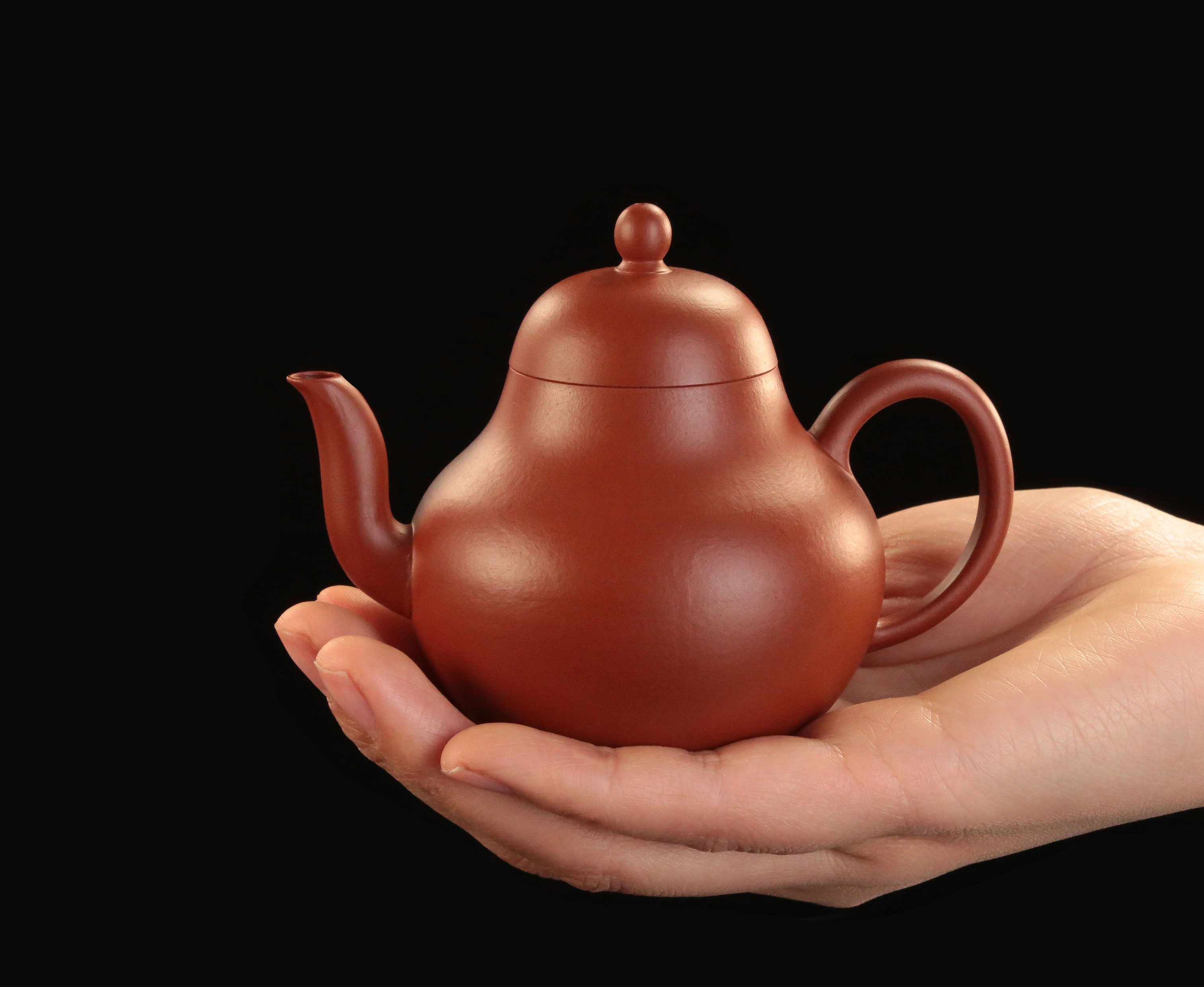
Thin-walled, pear-shaped Siting teapot







Thin-walled, pear-shaped Siting teapot
Thin-walled, pear-shaped Siting teapot
Volume: 150ml
Specifications: Length 11cm, Height 9cm
Inner diameter: 4cm
Appreciation of the Thin-walled Zhu Ni (Red Clay) Pear-shaped Si Ting Teapot
The "Thin-walled Zhu Ni Si Ting Teapot" is a category of Zisha teapots with extremely high craftsmanship, integrating three core elements: thin-walled technique , the characteristics of Zhu Ni clay , and the Si Ting teapot shape . It can be considered the "pinnacle of Zhu Ni teapots." The following is a comprehensive analysis from the perspectives of craftsmanship, appreciation, and collection:
I. Thin-walled Siting
The " Siting Pot ," created by Lu Siting , a renowned potter of the Qing Dynasty, is a classic pear-shaped pot. Due to the tendency of the rim to shrink and deform, the thin-walled Siting Pot is particularly rare. Thin-walled specifically refers to a pot body thickness of 1.2-1.5mm (compared to about 2-3mm for ordinary Zhu Ni pots), requiring the craftsman to possess top-notch hand-pounding and shaping skills.
Clay category :
Thin-walled Zhu Ni teapots are mostly made of Zhu Ni from small coal kilns or old Zhu Ni from Zhaozhuang , because of their high shrinkage rate (20%-30%), which makes the body appear thinner and more translucent after firing.
II. Analysis of Process Difficulties
Molding Challenge
Clay patting : The clay needs to be patted into a uniform thin sheet; even slight unevenness will cause stress cracking during firing.
Risks associated with joining parts : Due to the large difference in shrinkage of the clay at the joint between the spout, handle, and body, fine cracks are prone to appear.
The lid and mouth must fit tightly : the thin-walled lid and the mouth of the pot must be precisely matched. After firing, the deformation rate is as high as 40%, and the yield is extremely low.
Firing Limit
Segmented temperature control : initially, slowly increase the temperature (50℃/hour) to 800℃, then accelerate to 1080℃ and hold for 30 minutes to avoid "cracking".
Kiln support : Some craftsmen will place alumina pillars inside the pot for temporary support, which will be removed after the pot is taken out of the kiln, leaving a slight trace.
III. Key Points of Appreciation
Visual features
Transmittance : Under strong light, the body of the pot is slightly translucent, but not completely transparent (unlike slip-cast pots).
Wrinkled texture : The surface has naturally distributed "earthworm pattern" and "orange peel pattern", while imitations often show mechanically repeated patterns.
Proportional Harmony : The teapot is tall and upright, with the three-bend spout and handle in a golden ratio (the length of the spout and handle is approximately 2/3 of the height of the teapot).
tactile experience
Lightweight feel : A 200ml capacity pitcher typically weighs ≤100g, feeling weightless when held.
Warmth and smoothness : Even without soaking or conditioning, high-quality Zhu Ni clay feels like solidified cream, without the roughness of sandpaper.
Functional verification
Clean and crisp water cut-off : When the water is poured to 95% capacity, the spout can instantly cut off the water flow without any dripping.
Aroma test : After brewing highly aromatic tea, the teapot can still be smelled clearly after sitting for 5 minutes in an empty pot.
IV. Identification
Old Clay New Works : Replicating the Qing Dynasty Siting teapot shape using modern techniques, but bearing the marks of ancient masters (such as "Mengchen" and "Siting").
Inner wall marks : Genuine products have mud bench marks and scraping marks, while counterfeit products have smooth inner walls or mold lines.
Shrinkage texture : The shrinkage marks at the base of the spout and the edge of the mouth of a genuine thin-walled teapot are irregularly radial.
Sound test : When you lightly tap the clay with your finger, the sound of genuine Zhu Ni clay is like a chime, clear and resonant; the sound of a slip-cast teapot is like a dull thud.
V. Recommendations for Collection and Purchase
Author Selection
Established artisans and emerging ceramic artists :
In Dingshu Town, Yixing, young artists with the skill of thin-walled pottery can earn approximately 20,000 to 50,000 yuan for their works.
Clay priority
Small coal mine Zhu Ni > Zhao Zhuang old Zhu Ni > ordinary Zhu Ni, and a certificate of clay aging is required (aging period of ≥8 years is recommended).
VI. Maintenance Taboos
- Temperature control : In winter, warm the pot before brewing to avoid cracking caused by drastic temperature changes.
- Cleaning principles : Do not use dish soap. Rinse with boiling water immediately after use and air dry upside down.
- Patina formation : For the first 3 months, only brew a single type of tea (Wuyi rock tea is recommended), and gently wipe with a cotton cloth instead of a brush.
VII. Alternative Options
If you have a limited budget, you may consider the following similar product categories:
Thin-walled red clay Siting teapot : The clay has a low shrinkage rate (about 15%), and the price is only 1/3 of that of the Zhu Ni version.
Thick-walled Zhu Ni Si Ting teapot : Sacrificing some lightness, but with a high yield rate, suitable for daily use.
The thin-walled Zhu Ni Si Ting teapot is the ultimate fusion of craftsmanship, clay, and shape. Beginners are advised to start with the thick-walled Zhu Ni teapot and gradually progress to the thin-walled masterpieces.
A classic heirloom, embodying the beauty of simplicity, the pear-shaped teapot, a style originating in the Yuan Dynasty and popular in the Ming Dynasty, is named for its pear-like shape. This teapot is composed entirely of curved lines, its form dignified, elegant, and graceful. Simplifying complexity, its form is beautiful and refined, making it a true lady among teapots. Its full and rounded shape possesses a strength within, exhibiting a natural and harmonious beauty. The three-curved spout extends gracefully, while the rounded handle is gracefully curved, and the high, upright beaded knob offers a comfortable grip, evoking a sense of returning to nature. As the saying goes, "Without a pear-shaped teapot in hand, one cannot truly appreciate tea." Even with dozens of other Yixing teapots on the tea table, it doesn't prevent this one from being placed on the table.
Volume: 150ml
Specifications: Length 11cm, Height 9cm
Inner diameter: 4cm
Appreciation of the Thin-walled Zhu Ni (Red Clay) Pear-shaped Si Ting Teapot
The "Thin-walled Zhu Ni Si Ting Teapot" is a category of Zisha teapots with extremely high craftsmanship, integrating three core elements: thin-walled technique , the characteristics of Zhu Ni clay , and the Si Ting teapot shape . It can be considered the "pinnacle of Zhu Ni teapots." The following is a comprehensive analysis from the perspectives of craftsmanship, appreciation, and collection:
I. Thin-walled Siting
The " Siting Pot ," created by Lu Siting , a renowned potter of the Qing Dynasty, is a classic pear-shaped pot. Due to the tendency of the rim to shrink and deform, the thin-walled Siting Pot is particularly rare. Thin-walled specifically refers to a pot body thickness of 1.2-1.5mm (compared to about 2-3mm for ordinary Zhu Ni pots), requiring the craftsman to possess top-notch hand-pounding and shaping skills.
Clay category :
Thin-walled Zhu Ni teapots are mostly made of Zhu Ni from small coal kilns or old Zhu Ni from Zhaozhuang , because of their high shrinkage rate (20%-30%), which makes the body appear thinner and more translucent after firing.
II. Analysis of Process Difficulties
Molding Challenge
Clay patting : The clay needs to be patted into a uniform thin sheet; even slight unevenness will cause stress cracking during firing.
Risks associated with joining parts : Due to the large difference in shrinkage of the clay at the joint between the spout, handle, and body, fine cracks are prone to appear.
The lid and mouth must fit tightly : the thin-walled lid and the mouth of the pot must be precisely matched. After firing, the deformation rate is as high as 40%, and the yield is extremely low.
Firing Limit
Segmented temperature control : initially, slowly increase the temperature (50℃/hour) to 800℃, then accelerate to 1080℃ and hold for 30 minutes to avoid "cracking".
Kiln support : Some craftsmen will place alumina pillars inside the pot for temporary support, which will be removed after the pot is taken out of the kiln, leaving a slight trace.
III. Key Points of Appreciation
Visual features
Transmittance : Under strong light, the body of the pot is slightly translucent, but not completely transparent (unlike slip-cast pots).
Wrinkled texture : The surface has naturally distributed "earthworm pattern" and "orange peel pattern", while imitations often show mechanically repeated patterns.
Proportional Harmony : The teapot is tall and upright, with the three-bend spout and handle in a golden ratio (the length of the spout and handle is approximately 2/3 of the height of the teapot).
tactile experience
Lightweight feel : A 200ml capacity pitcher typically weighs ≤100g, feeling weightless when held.
Warmth and smoothness : Even without soaking or conditioning, high-quality Zhu Ni clay feels like solidified cream, without the roughness of sandpaper.
Functional verification
Clean and crisp water cut-off : When the water is poured to 95% capacity, the spout can instantly cut off the water flow without any dripping.
Aroma test : After brewing highly aromatic tea, the teapot can still be smelled clearly after sitting for 5 minutes in an empty pot.
IV. Identification
Old Clay New Works : Replicating the Qing Dynasty Siting teapot shape using modern techniques, but bearing the marks of ancient masters (such as "Mengchen" and "Siting").
Inner wall marks : Genuine products have mud bench marks and scraping marks, while counterfeit products have smooth inner walls or mold lines.
Shrinkage texture : The shrinkage marks at the base of the spout and the edge of the mouth of a genuine thin-walled teapot are irregularly radial.
Sound test : When you lightly tap the clay with your finger, the sound of genuine Zhu Ni clay is like a chime, clear and resonant; the sound of a slip-cast teapot is like a dull thud.
V. Recommendations for Collection and Purchase
Author Selection
Established artisans and emerging ceramic artists :
In Dingshu Town, Yixing, young artists with the skill of thin-walled pottery can earn approximately 20,000 to 50,000 yuan for their works.
Clay priority
Small coal mine Zhu Ni > Zhao Zhuang old Zhu Ni > ordinary Zhu Ni, and a certificate of clay aging is required (aging period of ≥8 years is recommended).
VI. Maintenance Taboos
- Temperature control : In winter, warm the pot before brewing to avoid cracking caused by drastic temperature changes.
- Cleaning principles : Do not use dish soap. Rinse with boiling water immediately after use and air dry upside down.
- Patina formation : For the first 3 months, only brew a single type of tea (Wuyi rock tea is recommended), and gently wipe with a cotton cloth instead of a brush.
VII. Alternative Options
If you have a limited budget, you may consider the following similar product categories:
Thin-walled red clay Siting teapot : The clay has a low shrinkage rate (about 15%), and the price is only 1/3 of that of the Zhu Ni version.
Thick-walled Zhu Ni Si Ting teapot : Sacrificing some lightness, but with a high yield rate, suitable for daily use.
The thin-walled Zhu Ni Si Ting teapot is the ultimate fusion of craftsmanship, clay, and shape. Beginners are advised to start with the thick-walled Zhu Ni teapot and gradually progress to the thin-walled masterpieces.
A classic heirloom, embodying the beauty of simplicity, the pear-shaped teapot, a style originating in the Yuan Dynasty and popular in the Ming Dynasty, is named for its pear-like shape. This teapot is composed entirely of curved lines, its form dignified, elegant, and graceful. Simplifying complexity, its form is beautiful and refined, making it a true lady among teapots. Its full and rounded shape possesses a strength within, exhibiting a natural and harmonious beauty. The three-curved spout extends gracefully, while the rounded handle is gracefully curved, and the high, upright beaded knob offers a comfortable grip, evoking a sense of returning to nature. As the saying goes, "Without a pear-shaped teapot in hand, one cannot truly appreciate tea." Even with dozens of other Yixing teapots on the tea table, it doesn't prevent this one from being placed on the table.





Frequently asked questions
Use the FAQ section to answer your customers' most frequent questions.
Order
Yes, we ship all over the world. Shipping costs will apply, and will be added at checkout. We run discounts and promotions all year, so stay tuned for exclusive deals.
It depends on where you are. Orders processed here will take 5-7 business days to arrive. Overseas deliveries can take anywhere from 7-16 days. Delivery details will be provided in your confirmation email.
You can contact us through our contact page! We will be happy to assist you.




